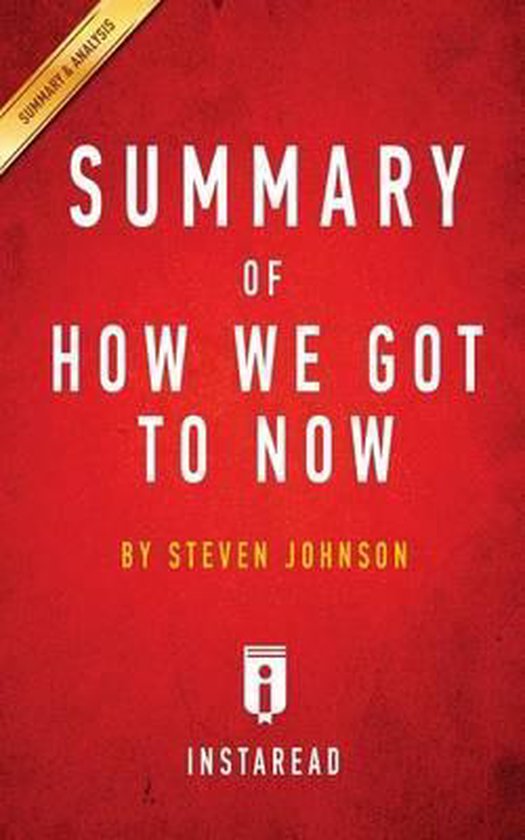Summary of How We Got to Now By Steven Johnson - Includes Analysis
Afbeeldingen
Artikel vergelijken
- Engels
- Paperback
- 9781945251245
- 21 april 2016
- 30 pagina's
Samenvatting
PLEASE NOTE: This is a summary of the book and NOT the original book.
How We Got to Now by Steven Johnson - A 15-minute Summary
Inside this Instaread Summary:
• Overview of the entire book
• Introduction to the important people in the book
• Summary and analysis of all the chapters in the book
• Key Takeaways of the book
• A Reader's Perspective
Preview of this summary:
Chapter 1
Glass formed in the Libyan desert about twenty-six million years ago when grains of silica became superheated for some unknown reason. People began making ornaments from it about ten thousand years later. Still later, Roman artisans learned to make glass windows and drinking vessels from these early examples of glass.
In 1204, Turkish glassmakers migrated to Venice, a major trade hub. The merchants of Venice happily began trading in this new commodity, but the high heat required for glassmaking kept sparking fires in the city. In 1291, the glassmakers were relocated to the island of Murano, where their creative community has thrived due to new levels of competition and shared innovation.
Murano glassmakers developed crystal, an extremely clear glass that bends light very precisely. Monks in northern Italy used it to create the first eyeglasses. Other than monks, most people did not read, so there was little demand for glasses until Johannes Gutenberg’s printing press made books accessible in the 1440s. Other innovators began studying the properties of convex pieces of glass. In 1590, a father and son in the Netherlands invented the microscope, which British scientist, Robert Hooke, used in the next century to discover the cell, the building block for life.
In 1608, Hans Lippershey patented a lens that magnified what a person was viewing through it. Galileo improved on the Lippershey’s design and, two years later, was using a telescope to challenge the assumption that all heavenly bodies revolved around the Earth. The printed word spread his ideas and helped pave the way for the Renaissance.
One hummingbird effect of glass came from a quest to measure things. In 1887, British physicist, Charles Vernon Boys, created a thin fiber of glass to use as a balance arm. The new type of glass, which would come to be called fiberglass, was very strong. Within a hundred years, fiberglass was widely used in insulation, airplanes and computer circuits.
Productspecificaties
Wij vonden geen specificaties voor jouw zoekopdracht '{SEARCH}'.
Inhoud
- Taal
- en
- Bindwijze
- Paperback
- Oorspronkelijke releasedatum
- 21 april 2016
- Aantal pagina's
- 30
- Illustraties
- Nee
Betrokkenen
- Hoofdauteur
- Instaread Summaries
- Tweede Auteur
- Instaread Summaries
- Hoofduitgeverij
- Instaread
Overige kenmerken
- Extra groot lettertype
- Nee
- Product breedte
- 127 mm
- Product hoogte
- 2 mm
- Product lengte
- 203 mm
- Studieboek
- Nee
- Verpakking breedte
- 127 mm
- Verpakking hoogte
- 2 mm
- Verpakking lengte
- 203 mm
- Verpakkingsgewicht
- 41 g
EAN
- EAN
- 9781945251245
Je vindt dit artikel in
- Taal
- Engels
- Boek, ebook of luisterboek?
- Boek
- Studieboek of algemeen
- Algemene boeken
Kies gewenste uitvoering
Kies je bindwijze
(2)
Prijsinformatie en bestellen
Rapporteer dit artikel
Je wilt melding doen van illegale inhoud over dit artikel:
- Ik wil melding doen als klant
- Ik wil melding doen als autoriteit of trusted flagger
- Ik wil melding doen als partner
- Ik wil melding doen als merkhouder
Geen klant, autoriteit, trusted flagger, merkhouder of partner? Gebruik dan onderstaande link om melding te doen.
